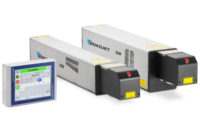In today’s challenging and competitive marketplace, converters are always looking for new ways to improve pressroom efficiencies or reduce operating costs. Frequently, these converters turn to their ink manufacturing partners for solutions to help achieve their cost-reduction goals for inks and consumables.
Mid-size printers, for example, need the flexibility to run different types of jobs on their presses from surface to lamination without having to stop and change inks.
Different end use application needs require different ink systems and thus downtime to clean the press and change the press configurations. This downtime leads to inefficiencies on press and adds time and complexity to jobs.
Many of these mid-size printers have come to ink manufacturers requesting an ink system that can be used effectively and interchangeably for both surface print and reverse lamination.
Multi-Purpose Inks
Taking advantage of its research and development resources, Sun Chemical listened to the request of mid-size printers and developed SunUno Solimax, a multi-purpose system that utilizes a single ink system for both lamination and surface printing.
By utilizing one single-ink system, complexity goes down by switching from several inks to choose from to only one ink that works universally. This universal ink approach impacts ink waste that is caused by wash-up and the changing of ink systems. With a multi-purpose ink, converters don’t have to change out inks or wash-up, so fewer consumables are used and less is required to start up a new job. This lowers the amount of time needed to clean the ink from the presses and decreases the amount of ink inventory needed in storage.
Multi-purpose inks are suitable for both flexographic and other print processes and can be applied to an extensive range of commonly used flexible packaging substrates with a wide variety of high-strength solvent-based colors, while still providing the needed high-quality package look required for shelf standout.
Multi-purpose inks, such as SunUno Solimax, can be used on OPP, OPA, PET, PE and selected coated film substrates used for a variety of applications, including lidding materials, confectionary, snack foods and dried foods.
Most importantly, multi-purpose inks must and do provide the benefits converters are looking for, including the ability to be printed at high speeds, maintain excellent adhesion, offer good scratch resistance, maintain high color strength and low dot gain, be PVC-free and maintain low solvent retention as well as providing the needed bond functionality
The typical ink system combines a technology vehicle with a base color to produce the finished ink. The technology vehicles are the part of the ink formula that gives all the properties to inks other than color, including gloss, rub, adhesion, resistance, printability and drying speed controls.
The base only gives the color and the technology vehicle supplies the properties, so it is important for an ink to get the right blend ratio to ensure that color remains strong without losing important technology vehicle properties. Multi-purpose inks achieve this blend ensuring strong color without losing technical quality in a print job.
There is also the benefit of consistency. By using one ink system that complies with the strictest regulations in the world, there is added reassurance that regulations are being followed globally.
High-Speed Inks
Another method many converters are using to improve pressroom efficiency is upgrading their presses to increase speed capabilities. Flexo press speeds continue to increase at an unparalleled pace with speeds approaching and even surpassing 2,000 feet per minute (FPM).
As press speeds increase, the design parameters for the inks used need to change. These changes ensure the inks dry at the appropriate rate in order to avoid defects in printed output.
There are a wide range of defects that can occur when inks are used without these new design parameters, beginning with dirty print, where large clumps of ink build up and transfer to the print web. This is not the traditional dirty print where the dots are bridging, but more a clump of ink many times larger than the half tone images that transfers to the print web. The defect varies in position from proof to proof.
Feathering is another defect where ink spreads out in an irregular fashion on the edge of a solid. The presence of a faint image on the printing area is a defect known as “ghosting.” This is typically seen where the anilox is plugging and/or the ink does not resolubilize quickly enough for the speed and the doctor blade opening.
Another challenge that frequently occurs with high-speed presses is misting. This occurs when the ink is transferring from the anilox to the plate, and the plate to the substrate under certain conditions. During the transfer process, a mist of ink will be transferred into the air. The inks will dry into a dust, falling onto the press parts such as the doctor blade chambers. Since this dust does not typically transfer to the web, it wastes ink and requires extra clean up.
One of the most common causes for defects is that the ink drying speed is incorrect. As press speeds increase, the ink drying speed needs to be slower. Historically, inks that are based on fast evaporating solvents tend to dry too fast, so as press speeds increase, a different combination of raw materials should be considered for high-speed presses.
Converters that are only moderately increasing press speeds may still use faster solvents in some cases, but studies show that more printers are currently using inks based with slower solvent blends.
The key challenge is to develop an ink solvent blend that both meets the needs of high-speed presses and maintain stability. Inks are typically not mono-solvent, but contain a mix of solvents that can include a percentage of alcohol, acetates and glycol ethers.
High-speed presses shear the inks more severely, exacerbating the volatility of the solvents, and it is critical that the ratio of these solvent blends stay the same during the press run. If the ink solvency changes over time during the press run, then the inks are not stable and equally capable of causing defects even with a slower drying solvent blend.
When defects occur as inks dry on plates and aniloxes on the high-speed press, it is because the ink resolubility is simply not good enough. Resolubility refers to the balance required between the ink resins and the solvent blend of the ink formulation. If the ink has poor resolubility, the resin cannot re-dissolve the partially dry ink on the anilox roller/plate so that it is transferred cleanly for the next impression.
In the microseconds that the ink comes in contact with the anilox in the doctor blade chamber and the plate comes in contact with the ink in the cells of the anilox, the ink has to resolubilize. To reach optimum resolubility, the solubility parameters of polymer and solvent need to match in order to improve high-speed flexo print quality.
Dynamic resolubilization of ink resins on the anilox depends upon print speed and solubility parameters of polymer and solvent. Poor match ups will contribute to dirty printing due to excessive drying in the anilox or poor bond strength for lamination to undesired retention of solvents. The solubility parameter is related to the cohesive energy density and ultimately dispersive, polar and hydrogen bonding forces.
This means that re-formulated inks for high-speed printing need to have a wider solubility parameter “window” so that resin solubility is not as sensitive to changes in the solvency and better balance can be achieved inside the solubility parameters. If the resin is more soluble, then slower solvent is needed so that the ink will better resolubilize on the plate and anilox.
Misting is seen when the deeper aniloxes are used (above ~6.0 – 7.0 BCM), so the best solution is to move to shallower aniloxes which minimize the misting defect. However, even with a shallower anilox, the expectation is that the same color strength will need to be delivered. This forces the ink strength to be higher. In summary, using finer aniloxes to get same color strength requires a stronger ink to be used.
Consumable Technology
One area that frequently leads to inefficiencies includes the time it takes to clean press parts and plates. Some printers lose additional production time with a press when they need to send out their anilox rollers to be cleaned or soda blasted. When the anilox on presses aren’t cleaned properly, printing defects like color match errors or dirty print caused by contamination can occur, leading to additional downtime.
To help printers improve efficiencies with cleaning, some manufacturers have developed high-performance and environmentally-friendly cleaning solutions. At Sun Chemical, we’ve developed SunVisto Anilox Renew and SunVisto Power Scrub.
The highly concentrated cleaner provides a deep cleaning foam that brings heavily soiled plates and anilox rollers back to their “like new” condition. By applying it weekly, most anilox rolls will not require bi-weekly removal and blasting, eliminating costs and improving overall quality. It also reduces the amount of wasted wash.
Conclusion
In a marketplace where mid-size converters are looking for ways to improve efficiencies and cut costs, flexo printers can find ways to achieve their goals by turning to their ink manufacturing partners for solutions to some of the challenges they would like to achieve. Multi-purpose inks, high-speed inks and even consumable technology are each examples of ways that printers have reduced expenses.
Sun Chemical
(973) 404-6172
www.sunchemical.com





